A instalação do WordPress no Mac permite que você explore seus recursos sem precisar de um host da Web.
Você conhecerá o funcionamento do WordPress e verá se ele é adequado para o seu projeto. Também é perfeito para testar temas e plug-ins antes de colocar seu site no ar. Além disso, fazer experimentos localmente lhe dá a liberdade de cometer erros e aprender.
Já brincamos muito com sites locais, tanto em computadores Mac quanto Windows. Neste tutorial, compartilharemos dois métodos simples para configurar o WordPress em seu Mac.
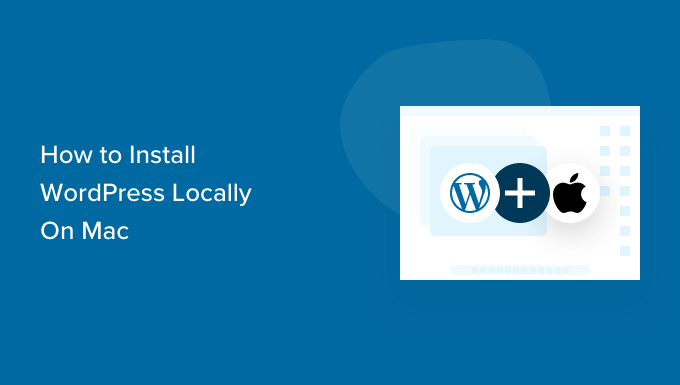
Observação: Não está usando Mac? Também temos um tutorial sobre como instalar o WordPress localmente no Windows.
Por que instalar o WordPress localmente no Mac?
Normalmente, você precisa de uma conta de hospedagem na Web e um nome de domínio para criar um site WordPress.
No entanto, o software principal do WordPress é gratuito para download e pode ser executado localmente em seu computador. Esse site local do WordPress geralmente não estará disponível na Internet e só poderá ser visualizado em seu computador.
A vantagem dessa abordagem é que você pode praticar em particular o uso do WordPress, experimentá-lo e ver que tipo de sites pode criar.
Você também pode usar essa instalação local para testar diferentes temas e plug-ins do WordPress antes de instalá-los em seu site ativo.
O que você precisa para instalar o WordPress localmente no Mac?
O WordPress é escrito principalmente em PHP, uma linguagem de programação do lado do servidor. Para executar o PHP, você precisará de um software de servidor da Web e de um sistema de gerenciamento de banco de dados MySQL instalado.
Agora, instalar todos esses softwares de forma independente e fazê-los funcionar uns com os outros parece uma tarefa assustadora.
Felizmente, existem ferramentas de desenvolvimento gratuitas que facilitam muito a instalação em um único pacote, mesmo para os usuários menos experientes em tecnologia. Com isso em mente, aqui estão dois métodos para instalar facilmente o WordPress localmente em um Mac sem nenhuma habilidade especial de administração de servidor:
Pronto? Vamos colocar o WordPress em execução em seu computador.
1. Instalar o WordPress localmente no Mac usando o WP local (recomendado)
O Local WP é uma ferramenta de desenvolvimento do WordPress que permite configurar facilmente um servidor local em seu computador Mac. Você também pode usar o Local no Windows e no Linux para configurar o WordPress.
Primeiro, você precisará visitar o site local e clicar no botão “Download” no canto superior direito da tela.
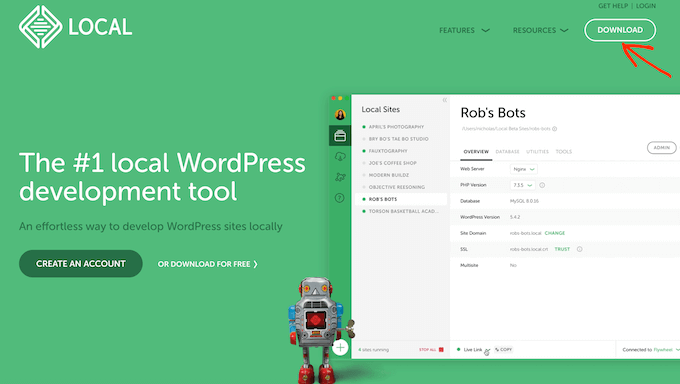
Isso abrirá uma janela pop-up Download Local.
Aqui, vamos escolher o Mac como sua plataforma.
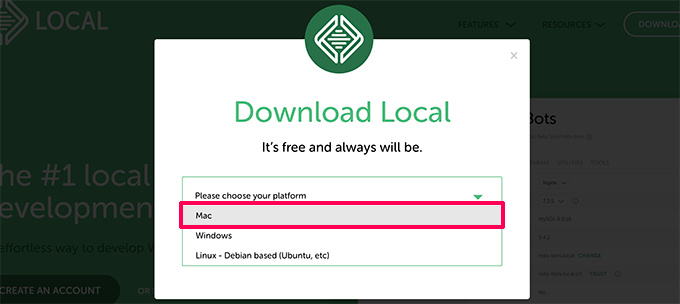
Em seguida, o local solicitará que você preencha um breve formulário.
Depois de digitar seu nome, endereço de e-mail e número de telefone, você pode clicar no botão “Get it Now”.
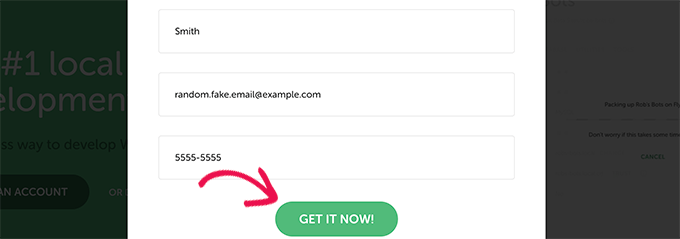
Isso fará o download do arquivo de instalação local para seu computador. Você pode clicar duas vezes para abrir o arquivo baixado assim que o download for concluído.
Em seguida, você verá um assistente de configuração que o guiará pelo processo de instalação do Local em seu computador.
Os usuários de Mac precisam simplesmente arrastar o aplicativo Local para a pasta “Aplicativos”.
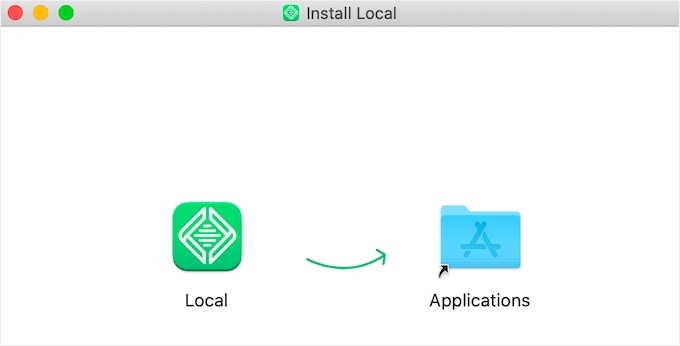
Quando a instalação for concluída, você poderá iniciar o aplicativo Local na pasta Aplicativos.
Na primeira inicialização, você poderá responder a algumas perguntas e criar uma conta local gratuita. Essas etapas são opcionais e você pode ignorá-las se quiser.
Criação de um site WordPress no local
O Local facilita muito a criação de um site local e a instalação rápida do WordPress.
Para começar, basta clicar no botão “Criar um novo site” para continuar.
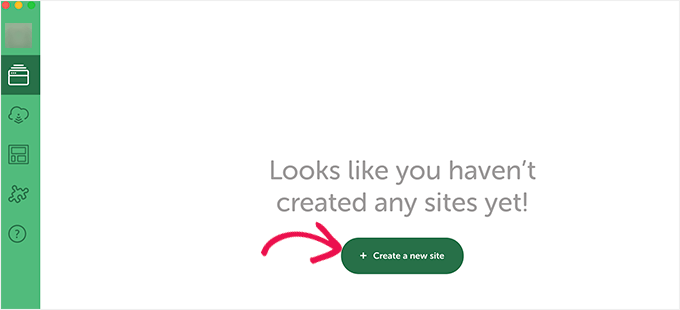
Na próxima tela, você precisará digitar o nome do site.
Depois disso, clique no botão “Continue” (Continuar).
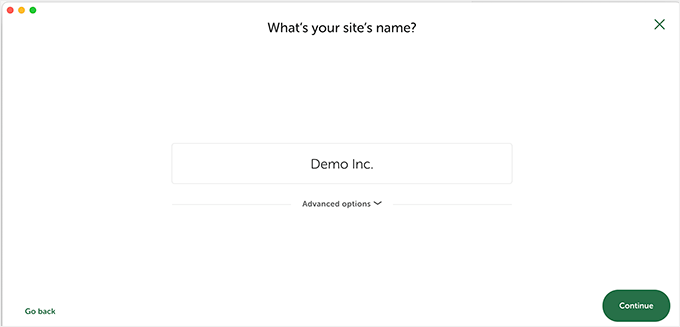
Em seguida, você será solicitado a escolher sua plataforma.
Local permite que você escolha a versão do PHP, Apache e MySQL que deseja usar.
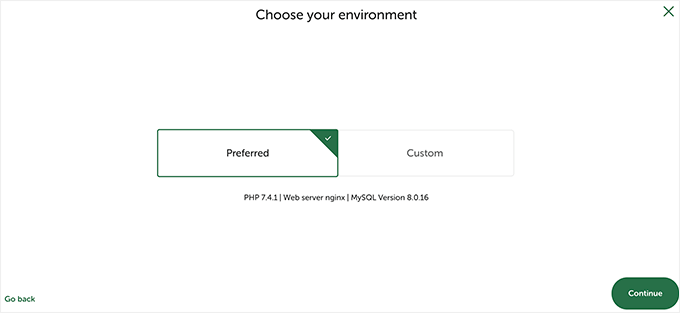
Se você não tiver certeza, escolha as configurações “Preferred” (Preferenciais) e clique no botão “Continue” (Continuar).
Por fim, será necessário inserir um nome de usuário e uma senha do WordPress. Em seguida, você pode clicar no botão “Add Site”.
O Local agora fará o download e instalará o WordPress para criar seu site. Poderá ser solicitado que você digite seu nome de usuário e senha do Mac para fazer alterações.
Quando terminar, você verá informações sobre o site recém-criado com botões para visitar a área de administração do WordPress ou visualizar o site local.
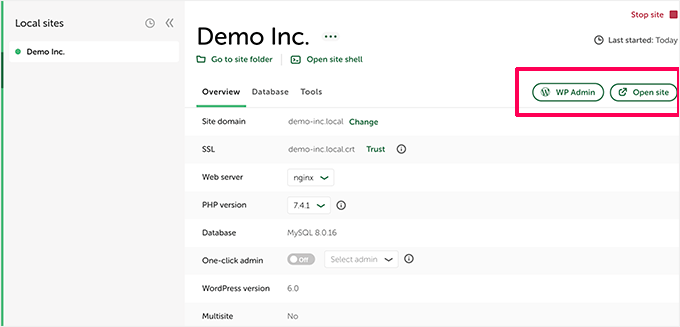
Agora você pode visitar seu site ou fazer login na área de administração do WordPress.
A partir daqui, você pode usar seu site WordPress hospedado localmente da mesma forma que gerenciaria um site ativo.
Você pode instalar plug-ins e temas e criar seu site como achar melhor.
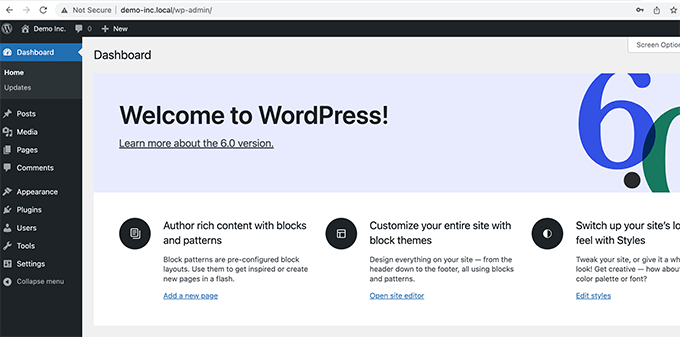
2. Instalar o WordPress localmente no Mac usando o MAMP
O MAMP é um programa popular que permite executar o WordPress em seu computador Mac.
Primeiro, vamos acessar o site do MAMP. Aqui você verá a versão mais recente do MAMP & MAMP Pro.
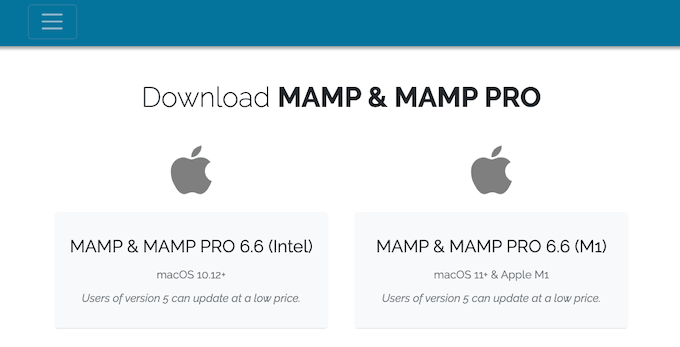
O MAMP tem downloads separados para diferentes versões do sistema operacional macOS.
Não tem certeza de qual versão do macOS está instalada em seu computador? Para descobrir, basta clicar no ícone da Apple na barra de ferramentas do seu computador.
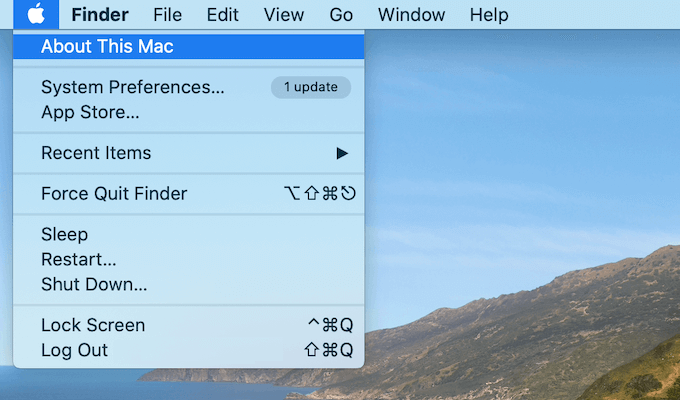
Em seguida, você pode clicar na opção “Sobre este Mac”.
Isso abrirá uma janela pop-up que mostra várias informações sobre seu computador, incluindo a versão do macOS.
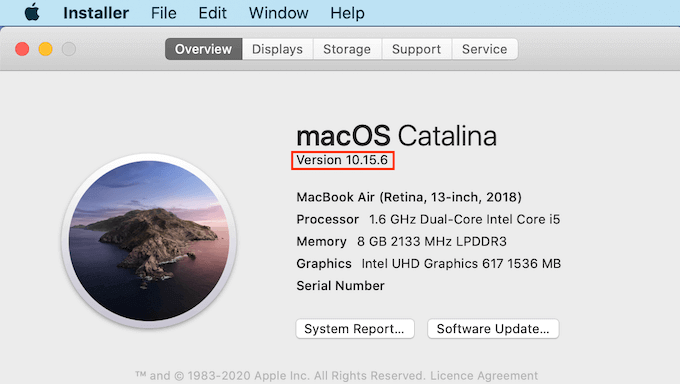
Agora você pode fazer o download da versão correta do MAMP para o seu sistema operacional.
Quando o download for concluído, clique duas vezes no arquivo .pkg do MAMP. Isso iniciará o instalador do MAMP.

Agora, basta seguir as instruções na tela para instalar o MAMP.
Depois de instalar esse programa, inicie o MAMP abrindo a pasta “Aplicativos” do seu computador.
Aqui, você encontrará duas versões do MAMP. O MAMP Pro é a versão paga, portanto, certifique-se de selecionar a versão gratuita.
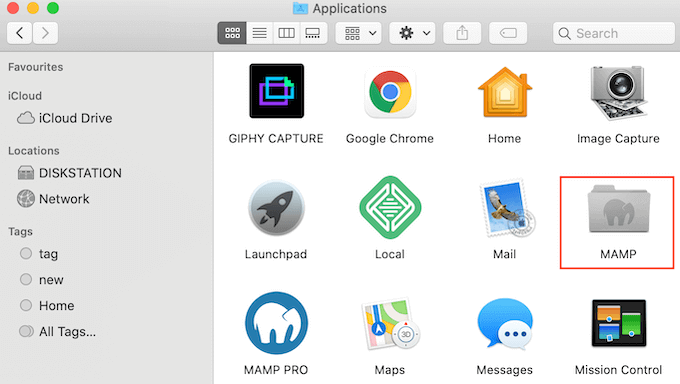
Dentro dessa pasta MAMP, você encontrará vários arquivos, além de um aplicativo MAMP.
Basta clicar duas vezes para iniciar o aplicativo MAMP.
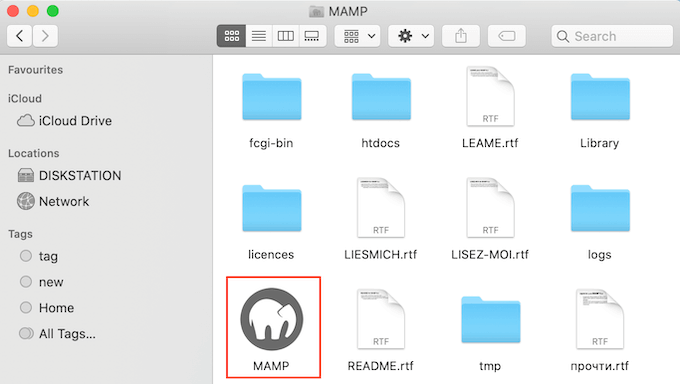
Antes de começar, recomendamos que você defina algumas configurações para melhorar sua experiência com o MAMP.
Para fazer essas alterações, clique em ‘MAMP’ na barra de ferramentas e selecione ‘Preferences….’
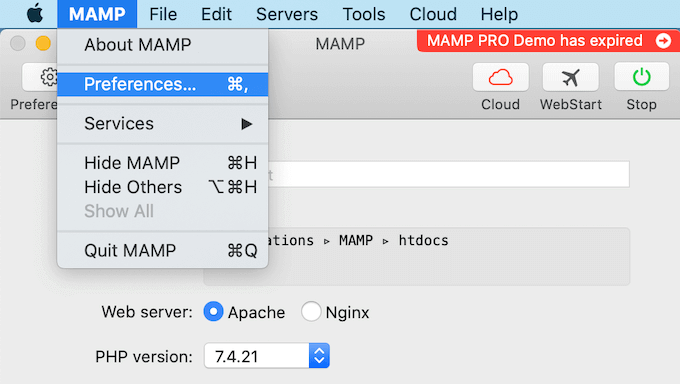
Na janela pop-up, você deverá mudar para a guia “Ports” (Portas).
Agora você pode verificar qual porta do Apache o MAMP está usando. Recomendamos mudar para a porta Apache 8888 se o MAMP ainda não estiver usando essa porta.
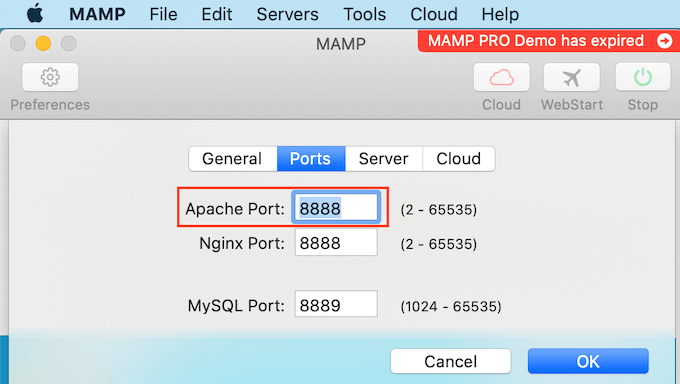
A próxima etapa é configurar a pasta raiz do documento. É nela que você criará e armazenará todos os seus sites locais do WordPress.
Por padrão, o MAMP usa a pasta /Applications/MAMP/htdocs/, mas você pode alterá-la para qualquer outro local.
Na caixa de diálogo “Preferências…”, clique na guia “Servidor”. Sua raiz de documento deve estar visível agora.
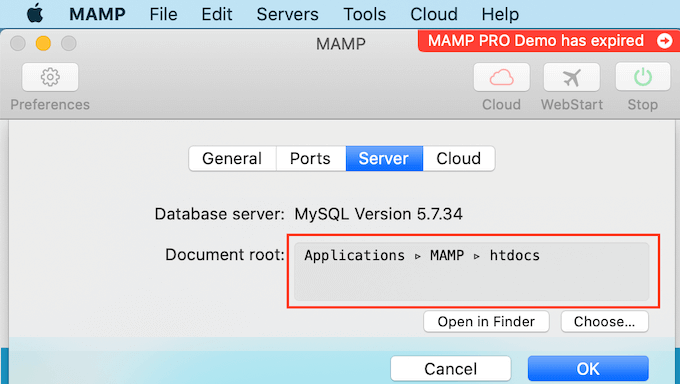
Para armazenar seus sites em qualquer outra pasta, clique no botão “Choose…” (Escolher…).
Isso abrirá uma janela pop-up na qual você poderá escolher um novo local. Talvez você também queira criar uma nova pasta para armazenar todos os seus sites do WordPress.
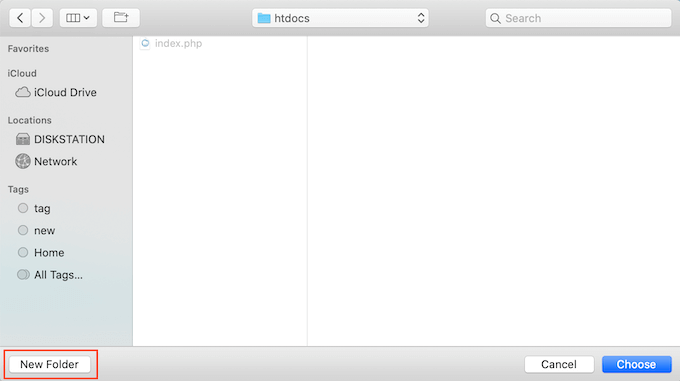
Você pode dar o nome que quiser a essa pasta.
Para este artigo, armazenaremos nossos sites em uma pasta chamada “allwebsites”.
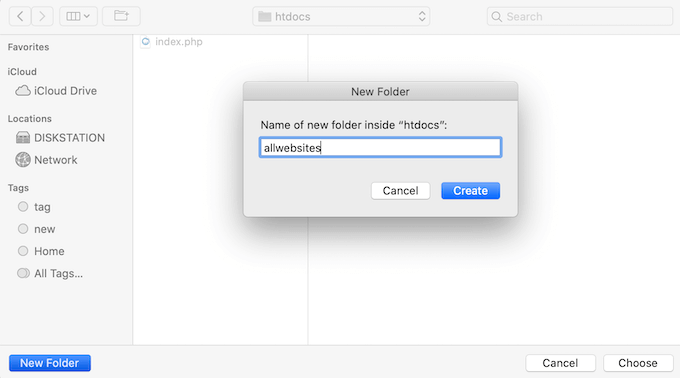
Instalação do WordPress no MAMP
Agora que você configurou o MAMP, é hora de instalar o WordPress em seu computador Mac.
Primeiro, você precisará acessar o site WordPress.org e fazer o download da versão mais recente do WordPress Core.
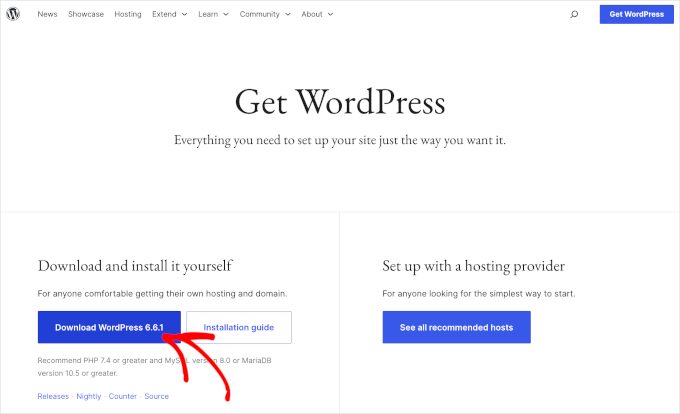
OBSERVAÇÃO: Existem duas versões do WordPress. Para obter mais detalhes, consulte nosso artigo comparativo sobre WordPress.com vs. WordPress.org.
Depois de fazer o download do arquivo do WordPress.org, basta descompactá-lo. Isso criará uma pasta descompactada “wordpress”.
Agora, basta copiar essa pasta na pasta raiz do documento do MAMP.
Como alteramos a pasta raiz do documento, precisamos copiar “wordpress” para applications/MAMP/htdocs/allwebsites.
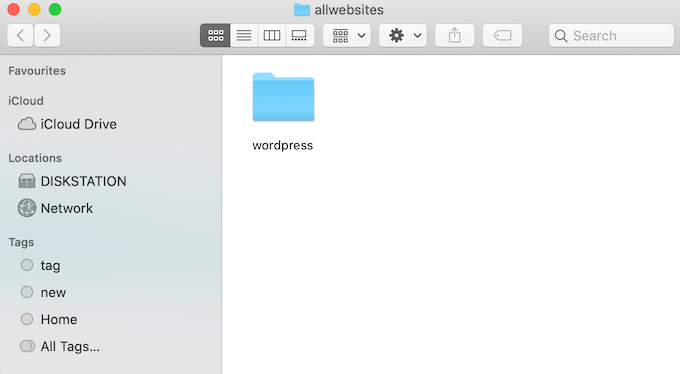
O WordPress precisa de um banco de dados para armazenar todo o seu conteúdo e dados. Você precisará criar esse banco de dados antes de poder criar um site local.
Não se preocupe – não é tão difícil quanto parece.
Na janela “Preferências…” do MAMP, basta clicar no botão “OK”. Isso deve iniciar o aplicativo MAMP em uma nova guia do navegador.
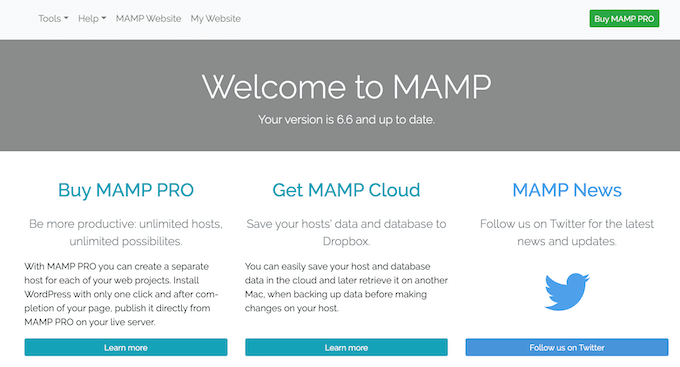
Sua próxima tarefa é iniciar o phpMyAdmin. Esse é um aplicativo baseado na Web para gerenciar o banco de dados MySQL do seu site.
Na barra de ferramentas, vamos navegar até Tools ” phpMyAdmin.
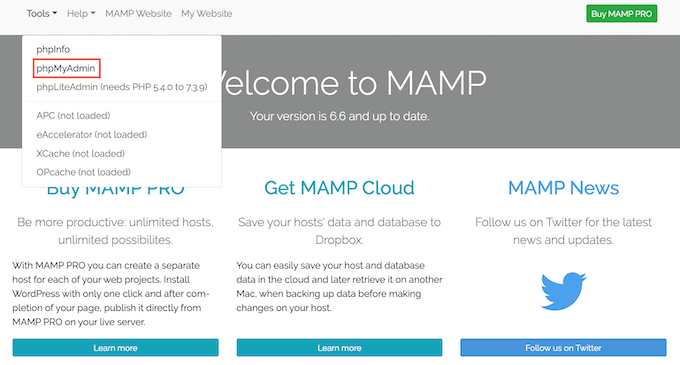
Isso abrirá o phpMyAdmin em uma nova guia.
No painel do phpMyAdmin, vá para a guia “Databases” (Bancos de dados).
Agora você pode digitar um nome para o seu banco de dados no campo “Database name” (Nome do banco de dados) com o que quiser. Não se esqueça de lembrar o nome, pois o usaremos na próxima etapa.
Para este tutorial, chamaremos nosso banco de dados de “test_db”.
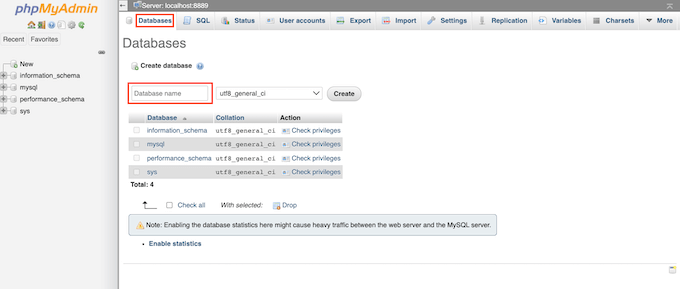
Depois de digitar o nome do banco de dados, você pode clicar no botão “Create” (Criar).
Em seguida, o PhpMyAdmin criará seu banco de dados.
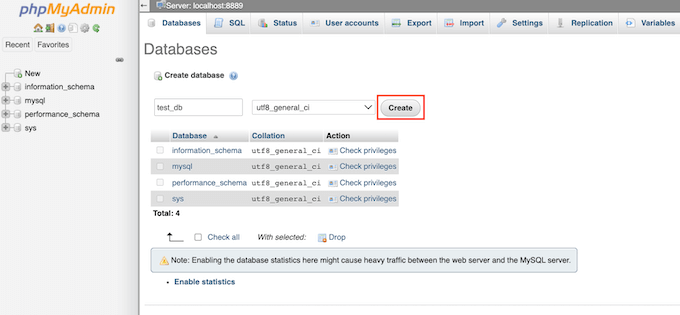
Agora, é hora de instalar o WordPress.
Em uma nova guia do navegador, basta acessar http://localhost:8888/. Se estiver usando uma porta diferente de 8888, basta alterar esse URL para mencionar sua porta.
Agora você deve ver um link para a pasta “wordpress” que copiou para a pasta raiz do documento. Vá em frente e clique nesse link. Isso abrirá o assistente de instalação do WordPress.
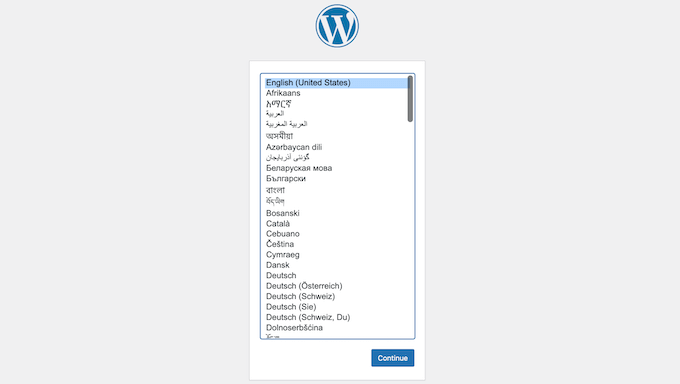
O assistente de instalação do WordPress começa pedindo que você escolha um idioma. Depois de fazer sua escolha, você pode clicar no botão “Continue” (Continuar).
Na próxima tela, o WordPress mostrará a lista de todas as informações necessárias para concluir a instalação.
Depois de ler esta tela, clique no botão “Let’s go” para avançar.
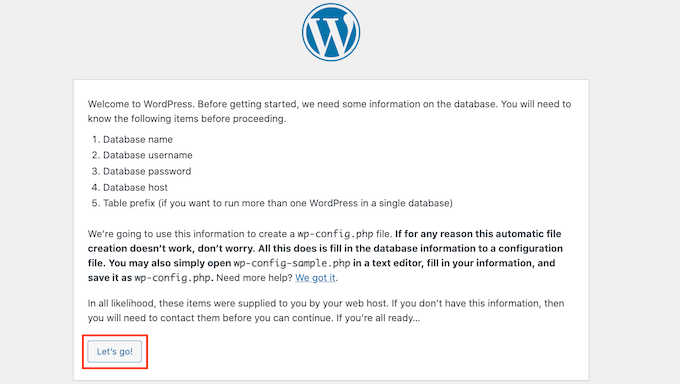
O assistente de configuração agora solicitará as informações do banco de dados do WordPress. Para o nome do banco de dados, basta digitar o nome que você criou na etapa anterior.
Para “Nome de usuário” e “Senha”, basta digitar “root”.
Em seguida, você pode digitar “localhost” no campo “Database Host”. Localhost significa que o banco de dados e o site estão hospedados no mesmo servidor, que, nesse caso, é o seu computador Mac.
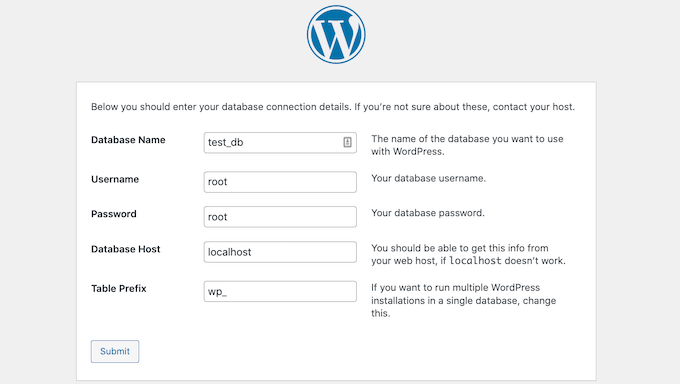
Depois de digitar todas essas informações, basta clicar no botão “Submit” (Enviar).
O WordPress agora se conectará ao seu banco de dados e criará um arquivo de configuração para você. Quando isso for concluído, você verá uma mensagem de sucesso.
Para passar para a próxima etapa, você pode clicar no botão “Executar a instalação”.
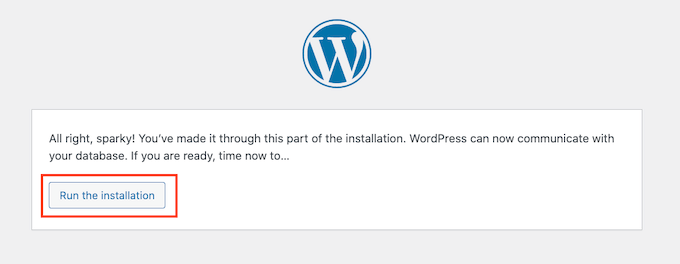
Na próxima tela, o WordPress solicitará que você adicione um título ao site. Por exemplo, você pode usar o nome da sua empresa. A maioria dos temas do WordPress mostra esse título na parte superior do site.
Se você não tiver certeza sobre o título do seu site, não precisa entrar em pânico. Você pode alterar o título em seu painel do WordPress a qualquer momento.
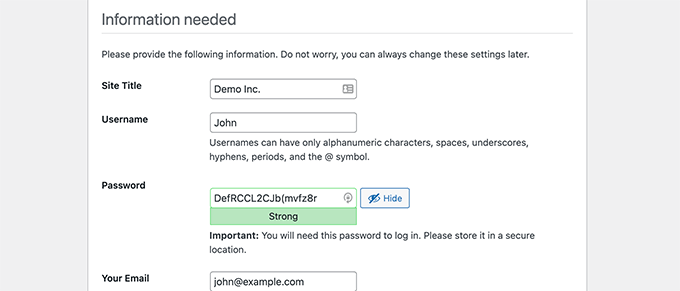
Em seguida, será necessário criar um nome de usuário e uma senha. Essas são as informações de login que você usará para acessar o painel do WordPress.
Você também pode digitar seu endereço de e-mail no campo “Your Email”. Esse é o endereço para o qual o WordPress enviará todos os e-mails de administração.
Depois de preencher esse formulário, clique no botão “Install WordPress” (Instalar o WordPress).

O WordPress agora executará a instalação.
Após alguns instantes, você verá a mensagem “Success!” (Sucesso!).

Para ir direto para a tela de login do WordPress, clique no botão “Log in”.
Você também pode fazer login no site local do WordPress usando o seguinte URL: http://localhost:8888/wordpress/wp-login.php
Observação: se estiver usando uma porta do Apache diferente, será necessário alterar a parte “8888” desse URL.
Agora, você pode prosseguir e fazer login no seu site WordPress inserindo o nome de usuário e a senha criados na etapa anterior.
Isso o levará ao painel de controle do WordPress.
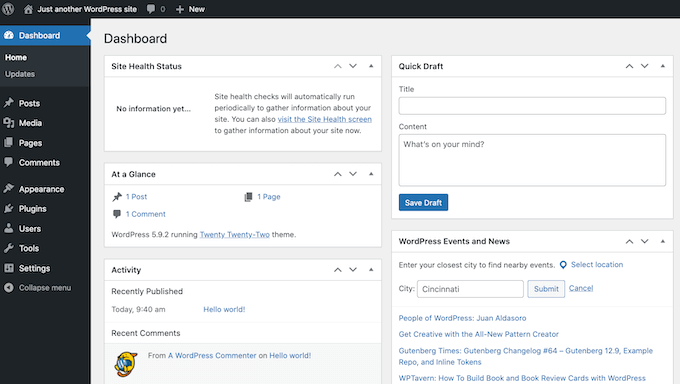
Experimentando o WordPress localmente no Mac
Uma instalação local é perfeita para testar o WordPress ou desenvolver sites em seu computador. Agora que o WordPress está sendo executado localmente em seu Mac, aqui estão algumas coisas que você pode querer experimentar:
- Faça experiências com os melhores temas do WordPress.
- Tente encontrar o tema perfeito para o WordPress.
- Teste os plug-ins essenciais do WordPress localmente.
- Aprenda a programar o WordPress criando seus próprios plug-ins e temas personalizados.
Como mover sua instalação local do WordPress para o site ativo
Depois de brincar com o WordPress localmente, talvez você queira mover a instalação do WordPress para um site ativo. Essa é a única maneira pela qual outras pessoas poderão ver seu site.
Para fazer isso, você precisará comprar um nome de domínio e uma hospedagem na Web.
Um nome de domínio é o endereço do seu site na Internet, e a hospedagem na Web é onde os arquivos do site são armazenados. Você pode pensar na hospedagem na Web como a casa do seu site na Internet.
Para hospedagem na Web, recomendamos a Bluehost. Ela é uma das maiores empresas de hospedagem do mundo e também é oficialmente recomendada pelo WordPress.org.
Felizmente, a Bluehost está oferecendo aos usuários do WPBeginner um desconto na hospedagem, um certificado SSL gratuito e um nome de domínio gratuito. Basicamente, você pode transformar sua instalação local do WordPress em um site ativo por US$ 1,99 por mês.
Depois de adquirir a hospedagem, talvez você queira ver nosso artigo sobre como mover o WordPress de um servidor local para um site ativo.
Esperamos que este artigo tenha ajudado você a aprender como instalar o WordPress localmente no Mac. Em seguida, talvez você também queira conferir nosso guia em sobre como criar um site com o WordPress ou ver nossa comparação das melhores empresas de hospedagem gerenciada do WordPress.
Se você gostou deste artigo, inscreva-se em nosso canal do YouTube para receber tutoriais em vídeo sobre o WordPress. Você também pode nos encontrar no Twitter e no Facebook.





Jiří Vaněk
Is it possible to change PHP versions in MAMP or modify the PHP.ini so that it is already optimized for the server from the first launch, to which the website will eventually be moved?
WPBeginner Support
MAMP does have options in its settings to change your PHP version if you wanted a different version
Admin
Jiří Vaněk
This sounds great, because sometimes one needs to test a website on different versions of PHP to find out the best behavior for a certain version. Great and thanks for the advice.
Denis Gradel
Thanks a lot! Localwp is much much easier than MAMP, I’ve tried both.
WPBeginner Support
Glad you found our recommendation helpful!
Admin
Kate
I get to
“WordPress needs a database to store all of its content and data. You’ll need to create this database before you can create a local website.
Don’t worry, it’s not as hard as it sounds!
In the MAMP ‘Preferences…’ window, simply click on the OK button. This should launch the MAMP application in a new browser tab.”
Then I don’t have an OK button and I can’t launch MAMP!
WPBeginner Support
You would want to ensure you have the latest version of MAMP installed and you have not disabled the Webstart page in the preferences section of MAMP for the most common reasons.
Admin
Mari
Hi there,
First, thank you for creating this guide, it was quite helpful. In fact, Ive been using my local site since march. But a few days ago when I went to log in to work on it I received this message on blank white screen,
“There has been a critical error on this website. Please check your site admin email inbox for instructions.
Learn more about troubleshooting WordPress.”
Im not quite sure what this means or where to actually go to rectify the error. Any instruction or an arrow on which way to turn would be humbly accepted. Thank you.
WPBeginner Support
For troubleshooting errors in general you would want to take a look at our guide below:
https://www.wpbeginner.com/beginners-guide/beginners-guide-to-troubleshooting-wordpress-errors-step-by-step/
Admin
RG
I’ve tried to install the wp locally.
But I’m stuck when I have to go to localhost/mywebsite
When I type this in the browser, I get an empty white page and when I click on the MAMP webstart / my website I get ‘forbidden you don’t have permission to access this ressource…
WPBeginner Support
You would want to ensure you are an admin on your mac and for the mywebsite URL you would want to ensure that is the name of the folder your WordPress site is installed in.
Admin
Robin
Hello,
I tried to follow this tutorial but got stuck when I had to go to the localhost
I changed to root in MAMP… my browser returns an empty white page
I don’t understand what the localhost stands for (is it the root on my MacBook or is it the root that I set during the setup of MAMP ?
WPBeginner Support
It is the URL that MAMP sets up to go to the folder on your site and properly load your site. If you changed the address for MAMP then you would need to go to that updated address.
Admin
Henry Barnett
I pop the URL Desktop/Wp_docs/vh_website into a new browser tab and ‘This site can’t be reached’. Can you please help?
WPBeginner Support
You would want to try reaching it using http://localhost
Admin
Sop
Thank you for this tutorial! I have successfully installed MAMP and have WordPress running locally. I’ve played around with it but would like to delete it now because I won’t be using WordPress anymore. What is the best way to do this?
WPBeginner Support
You could uninstall MAMP and delete the folder with your site information.
Admin
Lola
If localhost/mysite didnt work for you, check that you MAMP is running then click Webstart > My Webiste > Language and so on.
Thank you for the post,
WPBeginner Support
Thank you for sharing what helped you ensure the site was active
Admin
Russell
Having set up on my desktop (thank you so much!) and begun to build, I was trying to transfer everything to my laptop by copying the MAMP folder and the Mysite folder with all the WordPress files to the exact same places as my desktop. But I am unable to get it to work after a good few hours trying to figure a way through.
WPBeginner Support
For transferring your local installation, you would want to follow the steps in our guide below for properly transferring your content:
https://www.wpbeginner.com/wp-tutorials/how-to-move-live-wordpress-site-to-local-server/
Admin
Simon Miles
Nope, doesn’t work if you don’t understand computer science. This bit here – Go to localhost/mysite in a new browser tab. If you re-named the wordpress folder to something else, then use that name here – requires more explanation. I have no idea what to type in the browser.
WPBeginner Support
If you did not name the folder where you placed the WordPress files ‘mysite’ then you would replace the mysite in the URL with the name of the folder you decided to use.
Admin
kpatterson
I am running into an issue with the WordPress Installation Wizard on my browser, nothing is loading its just a blank screen, there are no errors displayed. Any advice?
WPBeginner Support
You would want to ensure MAMP is running and if it is to then use the debug option from our article below:
https://www.wpbeginner.com/wp-tutorials/how-to-fix-the-wordpress-white-screen-of-death/
Admin
jeania
I am having the same problem, how do you make sure that MAMP is running?
WPBeginner Support
You would open the MAMP program and if it gives the option to turn off your server then MAMP is running.
Admin
Geoff
wow, after 3 days messing around with other instructions I followed these and bingo I have wordpress running on de mac. Thank you.
WPBeginner Support
Glad our guide was helpful
Admin
Jennifer
Success! Thank you for these instructions. It took a little trial and error a few times, but I ultimately figured it out. One thing that tripped me up for a while was that apparently I needed to click on “start servers” in MAMP before the “Open web start page” would allow me to click on it. I didn’t see that anywhere in the instructions, so maybe that will help someone else. Thanks again! Onward with playing around with WordPress
WPBeginner Support
Thanks for sharing what helped you
Admin
nandhini
Thanks it helped me
Imran
The wordpress page was not opening on my Mac… then i changed localhost port setting back to 8888… and then it worked
WPBeginner Support
Glad you were able to find a solution that worked for you
Admin
Mel
Thank you for the very helpful article! Other articles were not up to date and the links to other articles at the end are useful
WPBeginner Support
Glad our article was helpful
Admin
sumeet
can we monetize the wordpress blog if we are hosting through MAMP
?
WPBeginner Support
Normally no as MAMP is for creating a local installation
Admin
Wendy
I managed to install wordpress finally and logged in, but once everything is closed and I want to get back to my local wordpress site, how do I access it? I feel like a total ditz right now…lol
WPBeginner Support
You would visit the localhost address you visited before and ensure MAMP is running before you try to visit the address
Admin
Elliott
How do you fix this issue? I see this when trying to access wordpress admin area
This page isn’t workinglocalhost is currently unable to handle this request.
HTTP ERROR 500
WPBeginner Support
There are a few different reasons, you may want to start with following our guide below:
https://www.wpbeginner.com/wp-tutorials/how-to-fix-the-internal-server-error-in-wordpress/
Admin
jane
i got half way then when it said to type in http localhost/mywebsite it didnt work
WPBeginner Support
You would want to ensure MAMP is running for the most common reason for that issue.
Admin
John
Thanks for the tutorial. Just one thing I’d like to mention… changing the default location of htdocs to one in my documents folder meant MAMP didn’t work. Changed it back to applications > MAMP > htdocs and it worked.
WPBeginner Support
Thanks for sharing this in case others ran into this issue or this is a change to MAMP since the last update of this article
Admin
Marianne
Thanks for sharing. I had the same problem.
Jen Harrigan
Thanks for the help, you are a lifesaver!
WPBeginner Support
You’re welcome, glad our guide could be helpful
Admin
Willy
When I put localhost/mysite in browser, I changed the folder´s name to wordpress_beginner so I put
localhost/wordpress_beginner in browser, but get error can´t find it??
WPBeginner Support
You may want to start by trying localhost and if that is not displaying correctly then you would want to ensure MAMP is running and does not have any errors.
Admin
Anjana
I copy the worpress folder to mamp folder and rename that folder with mysites name. When I try to run localhost:8888/mysites it gives
The requested URL /mysites/index.php was not found on this server.
Please help me
WPBeginner Support
Just in case, you would want to ensure MAMP is running when you try to visit the local installation
Admin
A
I get to the point of “Simply click on the Open Web Start Page button in MAMP application window”, but this option is greyed out and unclickable.. any thoughts on why this might be?
WPBeginner Support
One of the services may not be running correctly, in the tip right of the MAMP window there should be icons for each service with a green dot, if one of those isn’t green then that service could be the root of the issue.
Admin
Joanna Ma
I followed all the steps up until the installment, but I can’t open my http:localhost page, it just says error or unable to open on my screen. I’m not sure where I’m going wrong here, please let me know what else I should try!
WPBeginner Support
If you’ve come back after restarting your computer you would want to ensure MAMP is running so the local install can be found
Admin
Eva Giddings
Hey there, I have downloaded WordPress and created a database, but when I type localhost/mysite into the address bar it gives me a 404 not found error.
I just kept /Applications/MAMP/htdocs/ as my root folder, and I renamed the wordpress file to mysite. right now the wordpress folder is in htdocs, is that where it’s supposed to be?
WPBeginner Support
That all looks correct, are you certain MAMP is running before you tried to visit that address?
Admin
Dan
How do I restart WP on my mac to continue working on my site, I can’t find any info on how to do that.
Thanks,
Dan
WPBeginner Support
You would need to run MAMP again for the site to be findable at the address if that is what you mean.
Admin
Andrew
Wow. SUPER COOL and kind of you to take the time to post. This website is fantastic. THANK THANK THANK YOU!
WPBeginner Support
Thank you, glad you like our guide
Admin
Rick Karlson
I got to the point where you instructed to copy the WordPress to the MAMP Document root folder, AND you gave not a clue as to just where that might be found on my mac mini.
I dug through the MAMP files and folders (post install) and can find nothing like you reference. My opinion is your instructions are, without this small piece of info, useless.
WPBeginner Support
Some users may have changed where it is installed but normally you should see your MAMP folder in your Applications folder.
Admin
Joan Houston
So the “MAMP Document root folder” refers to the MAMP folder that got installed in the Applications folder? I, too, am confused by this.
WPBeginner Support
Correct
Peter Fritz Walter
Thanks for this comprehensive tutorial, it was very useful to me.
Peter
WPBeginner Support
Glad our guide could be helpful
Admin
Carrie
Oops! Looks like MAMP isn’t free anymore. I get as far as “Open WebStart Page” only to be directed to the website to purchase.
WPBeginner Support
From taking a look, they bundled the pro and free versions together. You should still be able to run MAMP for free
Admin
Tabish Hyyat
Hey! Kindly update the article….can’t work out which thing is which……
anurag
thanks , it is really helpful
Oleg
Thanks! Worked well.
Andrea
Hi, thanks for the great post! I have MAMP installed since a WordPress training I took suggested it. Does having MAMP serve as a localhost for testing my site serve the same purpose as using a subdomain as a staging site? I’ve read your articles on the latter, and am trying to understand. I guess one difference would be that if I used the MAMP method, I would always have to use my Mac; if I used a subdomain and just made it private, I could test from any computer. Am I thinking of this correctly? Basically, I am a beginner planning to start a blog, and want to make sure I have a testing environment. Thanks!
WPBeginner Support
Hi Andrea,
Yes, using MAMP you can create websites on localhost. These websites will only be accessible only on your computer. A staging website is on a live server that can be accessed using any computer.
Admin
Stan
Be aware that with MAMP 4.1.1 and PHP 7.1.1, you will see phpMyAdmin grayed out. The solution is to go into MAMP click the PHP tab and change PHP to 7.0.15. Presto !
By default MAMP shows only two versions of PHP , so if you don’t see 7.0.15 on list then rename folders with PHP versions you don’t want to use in the Applications/MAMP/bin/php folder.
Tara
I have changed the database charset in creating database tables, now I can not view my wepage or even in wp-admin. How do you find the database names from MAMP on a mac to change the database name back? Thanks
Fannie
When I’m in “phpMyAdmin”, I don’t see the tab “databases”, neither all the other options in the menu. I just see a table (grey and purple)… Someone know what I did wrong ?
Laura
Is there a newer version of this tutorial to go along with the current version of MAMP? The screenshots here are very different. Also, the instructions to create the document root aren’t very clear – first you advise putting it in a new folder in the Documents folder (which I did), but then you make it seem like it’s supposed to be in the MAMP folder in the Applications folder! I can’t get my localhost page to come up… This is my folder tree thingy…
Macintosh HD\Applications\MAMP\htdocs\WEBSITES\name\wordpress
What should my localhost address be?
I’ve also tried putting the WordPress folder here…
Macintosh HD\users\me\documents\WEBSITES\name\wordpress
I’m very confused.
BP
From the MAMP webpage click “my website”, 2nd from the left on the menu.
That will take you to the localhost site.
lisa
were you able to find a new tutorial?
Apoorv
This is so helpful..!! Worked like a Charm.
Charles Bewlay
I installed everything – brilliant – and was working on installing a template from template vendor. It asked to select a Cherryframework zip file. I did and then everything went blank. I’ve not been able to see anything since. I realised I had selected the wrong Cherryframework file – not the one in the template folder but one from outside that I had downloaded earlier and just had in my “new website’ folder.
I don’t really want to have to start from scratch. when I look at all my previous history I just get blank white pages.
Help!
Charles Bewlay
Many thanks guys, couldn’t have gone anywhere without you
Ed
I’m developing WordPress sites locally and then move it to a live server when i’m done. But when i start new projects locally I don’t really know how to handle the old files from previous work and databases?? Shall I just delete database, files and everything and start again??
Michael
Okay, so I setup my wordpress page using MAMP on my mac a few weeks ago and it was working and I was able to use edit the content. But going back to it now, I can’t seem to edit, just view my page. I start MAMP, go to the ‘WebStart Page’, click ‘My Website’ from the menu bar and choose my page. It loads, but I don’t see how I get to the WordPress editor??
Please help…
WPBeginner Support
We hope you have tried accessing your website’s admin area by visiting the URL:
http://localhost/wp-admin
This URL may differ depending on how you installed WordPress. Let’s suppose you installed it in a folder mysite, then your login URL would be.
http://localhost/mysite/wp-admin
Also check our guide on how to find your WordPress login URL.
Admin
Carolyn
It is unclear where to create the file below. I did not see this in MAMP or in the new window. If you are going to take people step by step in doing something, you need to be CLEAR!
Open a new browser window and type http://localhost/mysite. If you re-named the wordpress folder to something else, then use that name here. WordPress will notify you that it was unable to find wp-config.php file.
Click on Create a Configuration File button.
Create a Configuration file for WordPress in MAMP on Mac
M L Williams
I have everything installed and working, only I followed other instructions and didn’t use port 80. Plus I ended up using the default site htdocs inside Applications.
Is there a way I can have a do over, and reinstall everything the way you say to. I cannot may my site multisite, which was the whole reason I went down this rabbit hole.
Thanks so much for the article. It is well written and very helpful, just what I was looking for. Just wish I had found it first.
WPBeginner Support
Yes you can uninstall MAMP by simply visiting the Applications in Finder and then deleting MAMP.
Admin
Dee
Just wondering – what is the whole point of installing this on a MAC if we can work through the WordPress website? I’m trying to understand if I should bother downloading this onto my MAC or if it’s ok to just work through the regular website. Thanks.
Elisabeth Howlett
Very Helpful Article, from grateful person thinking that I would NOT be able to pull off MAMP then WordPress install. I actually did it!!!